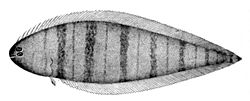This article needs additional citations for verification .(December 2016) |
| Symphurus pusillus | |
|---|---|
 | |
| Scientific classification | |
| Kingdom: | Animalia |
| Phylum: | Chordata |
| Class: | Actinopterygii |
| Order: | Carangiformes |
| Suborder: | Pleuronectoidei |
| Family: | Cynoglossidae |
| Genus: | Symphurus |
| Species: | S. pusillus |
| Binomial name | |
| Symphurus pusillus | |
The northern tonguefish (Symphurus pusillus) is a species of fish belonging to the family Cynoglossidae.
